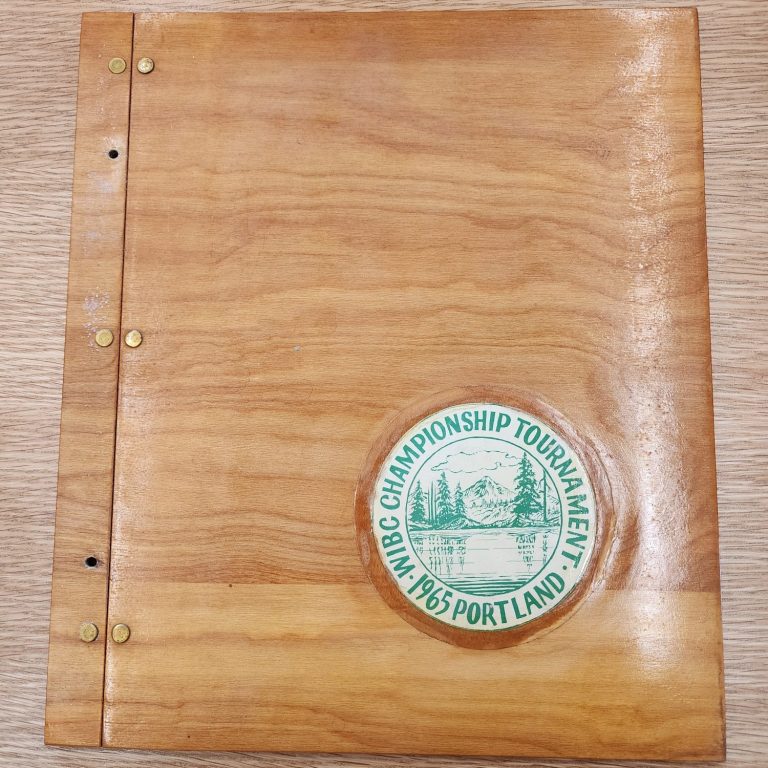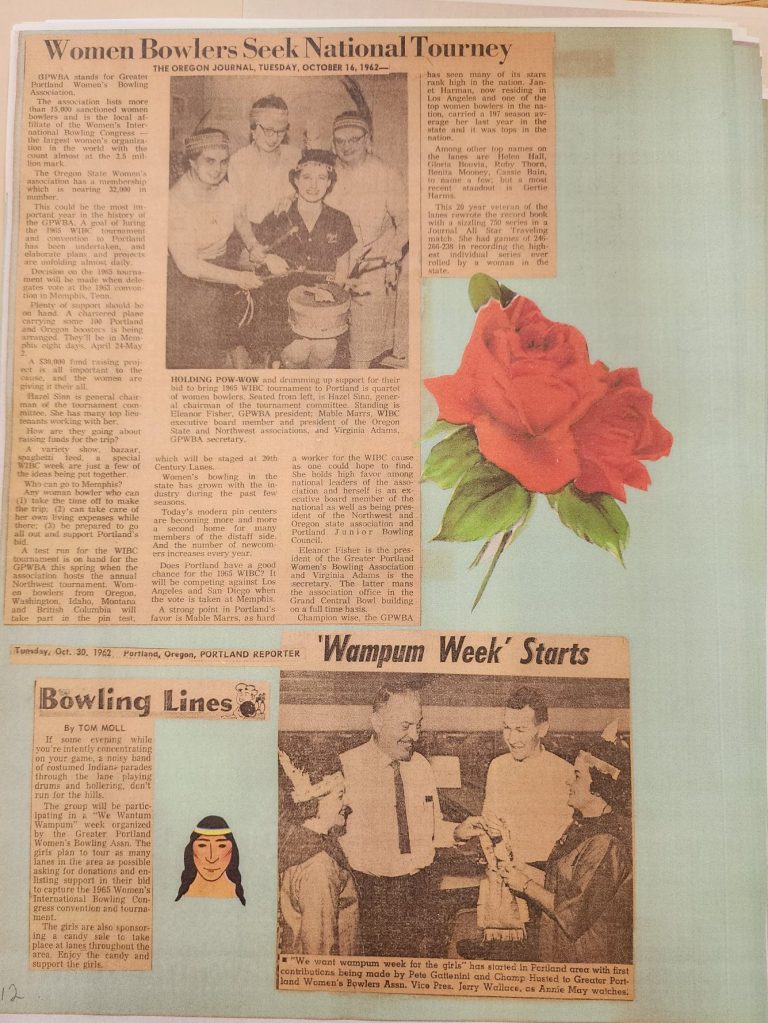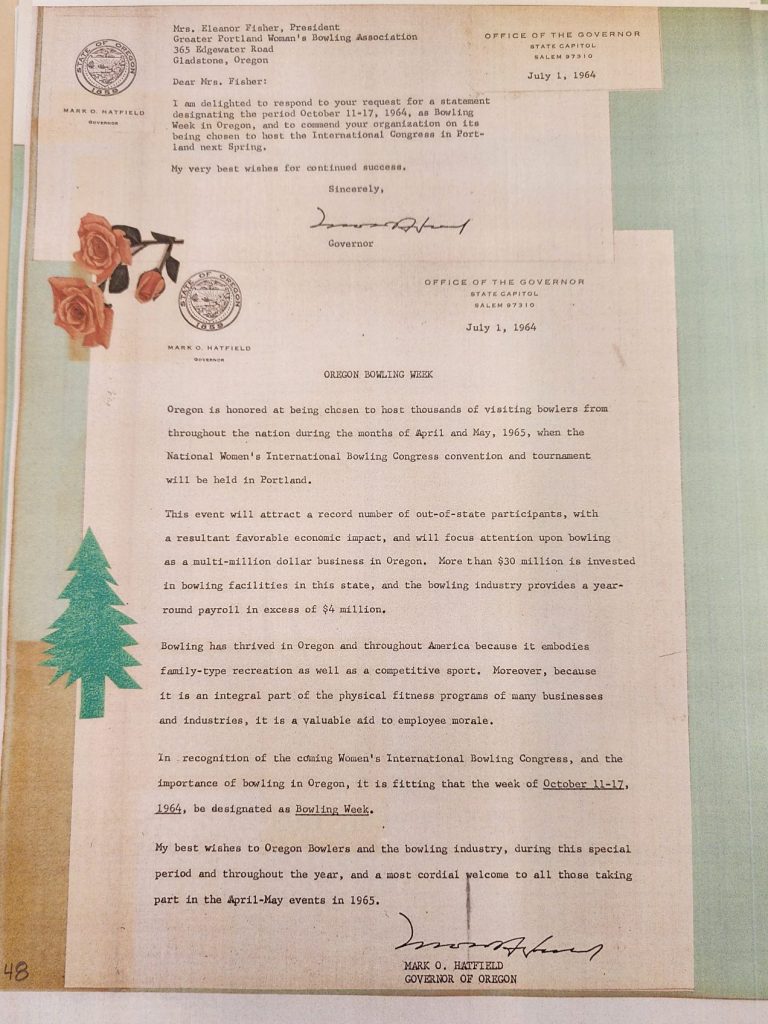Everything Came Up Roses
How Portland’s Women Bowlers Fought to Bring the 1965 National Championship to the City of Roses
By: Jim Ferretti
April 29, 2025

PORTLAND, Ore. — Sometimes the most incredible pieces of history are the ones we stumble upon by chance.
While researching bowling history for another project, I discovered that the Oregon Historical Society was in possession of a little-known but extraordinary artifact—a scrapbook detailing the full journey of how Portland earned the honor of hosting the 1965 Women’s International Bowling Congress (WIBC) National Championship Tournament.
Sifting through 363 carefully preserved scrapbook pages at the Research Library at the Oregon Historical Society was both an honor and a powerful step back into the rich story of bowling’s past. It’s these types of moments—unearthing the real, grassroots history of our sport—that remind us why we must never forget where bowling came from.
With the number of bowling centers shrinking every year, understanding and celebrating our history is more important than ever. If we want to keep the sport we love alive, we must continue telling these stories.
This is one of them.
The Campaign Takes Root
It all began in the spring of 1962. Delegates from the Greater Portland Women’s Bowling Association (GPWBA), returning from the WIBC convention in Phoenix, learned that the 1965 tournament site was still undecided. Portland wasn’t just interested—it was determined.
Led by GPWBA President Eleanor Fisher and Secretary Virginia Adams, the association immediately went to work. Fisher called an emergency meeting on June 5, 1962, and Portland’s campaign quickly bloomed into a full-fledged civic movement. Volunteers stitched silk roses, organized spaghetti feeds, hosted dances, and launched “Wampum Week”—a fundraising spectacle that featured themed costumes and skits at local bowling alleys.

The Bid That Blossomed
In July 1962, Portland submitted its formal bid to the WIBC. Backed by seven modern bowling centers, ample hotel space, and a strong transportation network, the bid was accompanied by letters of endorsement from Oregon Governor Mark Hatfield, Portland Mayor Terry Schrunk, civic groups, and business leaders.
But beyond infrastructure, Portland offered passion. “You have to make them see Portland, feel Portland, before they even get here,” Secretary Virginia Adams told The Oregonian in late 1962.
The campaign’s centerpiece was an original stage show called “Sights and Sounds of Portland,” featuring local talent, comedy, and music. The goal wasn’t just to win votes—it was to capture hearts.

Taking the Show to Memphis
By 1963, Portland had raised over $10,000—enough to charter a DC-7 aircraft to the WIBC Convention in Memphis. Nearly 80 delegates traveled, performing their stage show, handing out rose pins, and wearing crisp white uniforms with umbrellas bearing the slogan “Make it Portland in ’65.”
They even included a musical tribute to Packy the Elephant, the famed baby elephant born at the Oregon Zoo that year.
On April 30, 1963, Portland won the bid.
As Fisher and Adams returned home in the rain, their soaked clothes and tear-streaked cheeks symbolized the emotional victory. “It was like winning the Olympics,” Fisher said. “Only it was better—because we did it together.”

From Bid to Blueprint
Tournament planning began immediately. With over 20,000 competitors expected and a 10-week competition window, it was a logistical mountain. 20th Century Lanes was selected as the host site. The Portland Hilton became the headquarters. GPWBA Chair Nellie Green coordinated over 400 volunteers, all of whom worked without pay—welcoming bowlers at the airport, running hospitality rooms, and scoring every frame.
The volunteers wore rose-embroidered uniforms and badges that became symbols of Portland pride.

A City in Full Bloom
Throughout 1964, themed raffles, dances, and concerts kept excitement high. In July, Governor Hatfield declared October 11–17 as “Bowling Week,” celebrating the sport’s contribution to Oregon life. Cities across the state followed suit.
That summer, Portland received the ceremonial “Gold Ball,” passed from host city to host city. “We’ll carry the Gold Ball on the green carpet to the Fir West,” Nellie Green declared at the unveiling—echoing the tournament’s official slogan.
Flyers and brochures showcased Oregon’s beauty—Mount Hood, the Columbia River Gorge, downtown Portland—and were distributed in bowling centers nationwide.

The Kickoff and the National Push
On August 13, 1964, more than 1,000 guests packed the Hilton ballroom for the official Kick-Off Rally. Hosted by former Notre Dame football coach Frank Leahy, the event featured WIBC President Alberta Crowe, Executive Secretary Emma Phaler, and local leaders. The Portland Rainmakers civic group stole the show with a routine featuring upside-down umbrellas, fir trees, and a giant gold bowling pin.
From there, the “Have You Entered?” campaign swept across the country. Posters appeared in hundreds of bowling alleys. Cities like Seattle and Tacoma even began competing to see who could send more teams.
The results exceeded expectations: over 4,000 teams registered, far surpassing the original goal of 2,000.

Portland’s Moment Arrives
On April 8, 1965, bowlers from all over the country rolled into Portland. Opening ceremonies at 20th Century Lanes featured remarks by Howard Traver of the Portland Mayor’s Office and Warren Huitt from the Governor’s staff. As cameras flashed and cheers rang out, Portland’s years of preparation came to life.
The 1965 WIBC National Championship Tournament unfolded over ten weeks, delivering record-setting participation, top-tier competition, and unforgettable moments.
Roseburg bowlers stood out with strong showings in both singles and team events, and Oregon’s presence was felt on leaderboards throughout the tournament. One of the most notable efforts came from a five-woman team representing the Greater Portland Women’s Bowling Association in Division II. Led by team captain Pat Noonan, a first-year league bowler, the team finished just 11 pins short of the Division II team title, placing fourth overall. Noonan’s impressive 600 series helped anchor the performance and was widely praised by tournament officials.
The final prize lists spanned pages of local newspapers. Close finishes, dramatic turnarounds, and spirited team efforts filled the lanes daily.
At the tournament’s conclusion, a Western Union telegram from WIBC President Alberta Crowe was read aloud at 20th Century Lanes:
“As the curtain comes down on this very successful tournament, my very best wishes to one and all.”

Everything Came Up Roses
From grassroots vision to record-breaking execution, Portland’s hosting of the 1965 WIBC National Championship was a masterclass in community spirit, volunteer commitment, and women-led leadership. The city’s embrace of the tournament created a blueprint for how sports events could unite a community and elevate women’s athletics.
“In the end,” said longtime GPWBA member Helen Martin, “we didn’t just win a bid—we showed the country what a team of women with a vision could accomplish.”
And in every sense of the phrase, everything truly came up roses.

The scrapbook stands as more than just a collection of photographs and clippings — it is a living testament to the vision, passion, and perseverance of the women who forever changed Portland’s place in bowling history. Every page tells a story of a community that came together with purpose and pride to achieve something extraordinary. It captures a moment when dreams were chased with umbrellas, roses, and pure determination. For those who would like to experience this piece of history firsthand, a full gallery of the scrapbook images is available at the link provided HERE.
©Copyright. All rights reserved.
We need your consent to load the translations
We use a third-party service to translate the website content that may collect data about your activity. Please review the details in the privacy policy and accept the service to view the translations.
